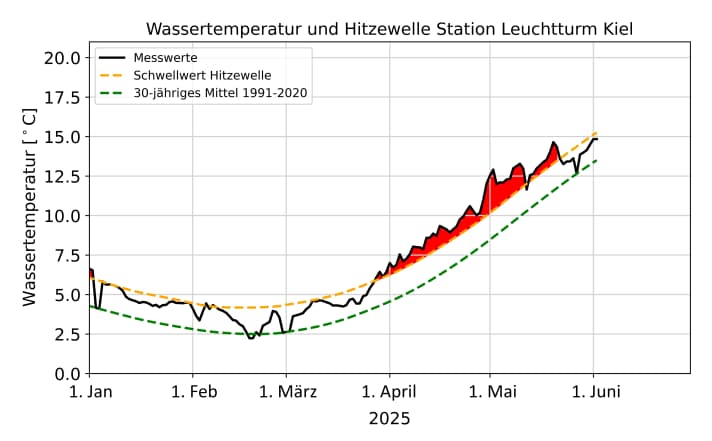
"In spring, the temperature of the North Sea rose to an average of 8.7 degrees - the highest since our current data began in 1997. This is an average of 0.9 degrees above the long-term average from 1997 to 2021. Almost the entire North Sea was at least 0.5 degrees warmer than usual at the surface, with significant upward outliers," explains Dr Tim Kruschke, Head of the Marine Climate Division at the BSH.
The greatest deviations occurred in the eastern North Sea off the Norwegian and Danish coasts, where temperatures were up to 2 degrees above the long-term average. These are the highest spring temperatures recorded by the BSH for large parts of the northern and central North Sea since 1997.

In the German part of the North Sea, surface temperatures were also well above the long-term average - between 0.8 and 1.5 degrees. Depending on the location, it was the fourth to sixth warmest spring since 1997.
Baltic Sea: German waters more than 2 degrees warmer
The Baltic Sea reached an average temperature of 5 degrees in spring, the sixth warmest spring since 1997 with 1 degree above the long-term average. Regional differences were clear: the far north was slightly colder than average, while the south was significantly warmer.
In the south-western part of the Baltic Sea, which includes German waters and the Danish islands, temperatures were more than 2 degrees above the long-term average. This makes it the warmest spring since current data began in 1997.
Kiel: Marine heatwave lasted for over 55 days!
From 28 March to 21 May 2025, the BSH measuring station at Kiel Lighthouse recorded a marine heatwave at a water depth of half a metre.
What are marine heatwaves?
- Marine heatwaves are extreme events in which the temperatures for at least five days are among the highest ten per cent of the values measured over 30 years at the location in question for the respective season.
"This marine heatwave lasted 55 days - the longest we have ever measured at our station in Kiel, where we have been collecting data continuously since 1989. Temperatures during the marine heatwave were on average 2.6 degrees above the mean value from 1991 to 2020, with a maximum value of 4.3 degrees above average," reports Dr Claudia Hinrichs, climate scientist at the BSH.

Climate change: North Sea and Baltic Sea getting warmer and warmer
The BSH analyses the surface temperatures of the North Sea and Baltic Sea on a weekly basisby combining satellite data with measurements from stations and ships. Based on the weekly averages for March, April and May, the spring average for 2025 was calculated and compared with the spring average from 1997 to 2021.
The BSH prepares such analyses as part of the DAS basic service "Climate and Water", which is operated together with other federal authorities as part of the German Strategy for Adaptation to Climate Change (DAS) in order to advise various stakeholders in politics and society.
Dr Kerstin Jochumsen, Head of the Oceanography Department at the BSH:
Our data shows that the North Sea and Baltic Sea are continuously warming. This is a direct consequence of climate change and is increasingly changing the marine environment.
